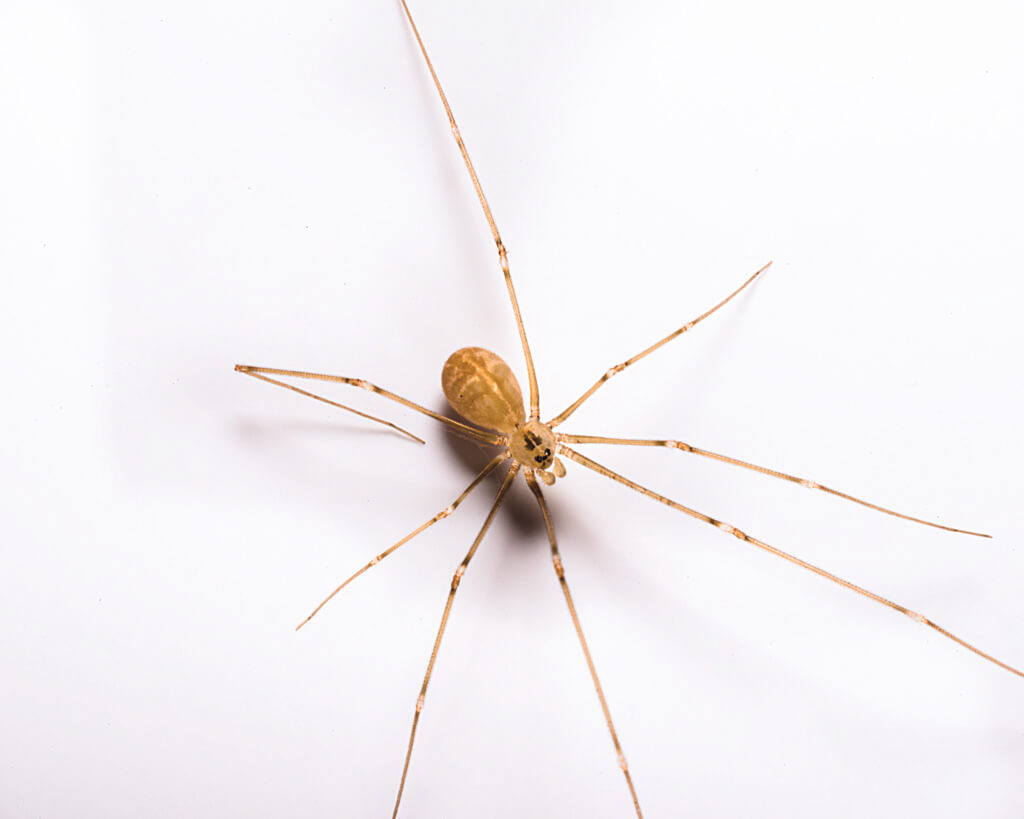Spiders aren’t a seasonal pest, but many of our customers notice an increased presence in their homes in the early fall months as the arachnids become more obvious while they search for a mate. Do you have spiders in your home? Remember to contact us for your pest control needs.
Here Are The Kansas City Spiders You Might See
Kansas City is home to a diverse range of spiders, including the Black Widow, Brown Recluse, Cellar Spider, Fishing Spider, Funnel Weaver Spider, Giant House Spider, Harvestmen, and Hobo Spider. While some of these spiders may be harmless, others can be dangerous and should be avoided. In this article, we’ll provide you with information about spider species, including their physical appearance, habitat, behavior, and potential risks. Whether you’re a resident or a visitor to Kansas City, this guide will help you identify and stay safe around spiders in the area.
Below are a few of the creepiest crawlers that love to Haunt Your House once fall hits. We’ll help you identify spiders native to Kansas City that you may find and that we’re happy to help treat!
The Common Spiders In Your Home

Identifying features: House spiders are often yellowish-brown in color with an elongated abdomen.
These are normally the spiders we receive calls about. Outside, they are often found spinning webs around windows and under eaves, especially near light sources that attract prey.
True facts:
They are a nuisance but pose no threat to humans.
Cellar Spiders (or Daddy-Long-Legs)

Identifying features:
-Color = pale yellow to light brown in color
-Equipped with long, skinny legs and a small body
Home hiding spots:
-Dark and damp places, such as cellars, basements and crawl spaces.
True Facts: Cellar spiders do not bite and therefore pose no threat to humans.
True or Myth?: Urban legend has it that their venom is the most deadly of all spiders, but their weak mouthparts keep them from injecting venom into humans.
The Brown Recluse
Perhaps the creepiest of them all, the thought of these non-aggressive spiders is more terrifying than their actual presence. Their name says it all — they love to HIDE and you probably won’t see much of them unless you really go searching!

Are brown recluse spiders found in Kansas City?
Yes. Brown Recluse spiders in Kansas City are spotted mostly in older homes and businesses. These spiders are rarely found outside their range in the south-central and central Midwestern States.
True (and not-so-fun) facts About spiders:
- Once in a desirable nesting site, brown recluse spiders can occupy the same space for generations.
- Indoor, they can be found in dark cracks, in stored items in garages or basements, under or between objects like cardboard boxes, between pages of a newspaper, etc.
- Bites are rare, but in some cases, the venom can leave a wound that is slow to heal and very rarely results in death.
- Bites are routinely misdiagnosed and are actually more often from other spiders or insects.
How To Identify This Spider:

- Check the top of the spider’s body for a distinctive violin or fiddle-shaped marking
- Body = 3/8th inch (11mm long) – about the size of a quarter when you include the legs.
- Has three pairs of eyes at the bottom of the “fiddle”
- Color = light gray-brown
Tips to lower and avoid contact with spiders:
Tips found on Pestworld.org
- Avoid keeping clothing and shoes on the floor, especially if in an area known for spiders; consider storing inside plastic containers.
- Seal cracks and crevices around the home.
- Vacuum/sweep away webs in and around the home.
- Shake out all clothing that has been in the laundry basket before wearing/washing.
- Keep garages, attics, and basements clean and clutter-free.
- If a spider bites you, contact your primary care physician for medical advice.
Common Spiders Found In Kansas City FAQs
Are There Poisonous Spiders In Kansas City?
There are two species of poisonous spiders in Kansas City, the brown recluse and the black widow. Their bites are extremely rare, but here's what to look out for.
What Is The Most Common Spider In Kansas?
This aptly-named insect is the most common type of spider to be found in Kansas homes. They have a brownish-yellow color, with dark lines angled on their legs and bodies. At full adult size, house spiders can grow to be about 5/16th of an inch in length.
What Are Common House Spiders In Missouri?
Common house spiders (Parasteatoda tepidariorum), cellar spiders (Pholcus spp.), crab spiders (Xysticus spp.), and yellow garden spiders (Argiope aurantia) are frequently seen in gardens or residential areas.
How Common Are Brown Recluse Spiders In Kansas City?
Are brown recluse spiders found in Kansas City? Yes. Brown Recluse spiders in Kansas City are spotted mostly in older homes and business. These spiders are rarely found outside of its range in the south-central and central Midwestern States.
Are There Any Dangerous Spiders In Missouri?
There are two medically significant spider species native to Missouri, the black widow and the brown recluse. If bitten by one of these spiders seek medical help immediately. It is not worth waiting to see if you have any reaction to the bite.
**If you have an infestation in your home, call us (816) 444-2847to inspect and treat your spider problem.**
Be sure to schedule your residential pest control service.









